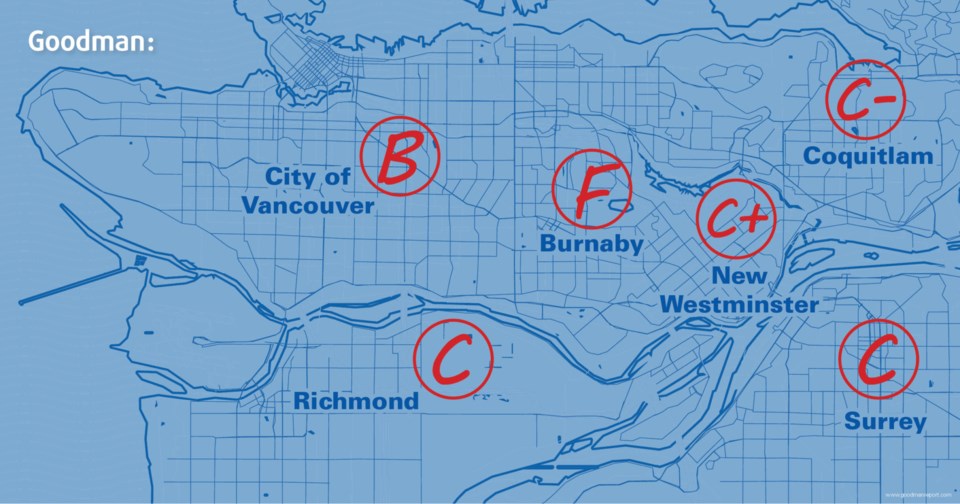A real estate firm has given New Westminster a C+ for its implementation of transit oriented development areas — one of the highest marks it doled out to municipalities.
Goodman Commercial, a Metro Vancouver real estate firm specializing in apartment buildings, commercial properties and development sites, has issued a transit-oriented area (TOA) implementation report card. The report card provides Goodman Commercial’s view on how six major Metro Vancouver municipalities have performed in implementing the province’s new TOA legislation, part of the legislative changes introduced last fall aimed at facilitating the delivery of more housing
In its report, Goodman said the provincial government passed its TOA legislation in late 2023, setting up “an inevitable tug-of-war” with B.C. municipalities, some of which immediately decried the perceived provincial overstep into their jurisdiction. It stated that some signs of “resistance” have emerged since the June 30, 2024 deadline for municipalities to designate properties within the 104 TOAs across B.C. has passed.
“Burnaby, for example, has refused to participate at all, while Coquitlam has designated properties, but is discouraging applications until some undefined future date when they might enact the policies required to support the new density,” said the report. “The result is a chaotic regulatory patchwork in the Metro Vancouver region.”
The report said the regulatory patchwork is creating uncertainty in the industry.
“In most jurisdictions, details that can make or break an investment have yet to be solidified, and timelines to get the complete picture are murky at best,” said the report. “Rumours and speculation are thriving in an environment where policy guidelines are half-baked, and nobody can be certain what will happen next week, let alone next year.”
The City of Vancouver received a B in the report card, the highest rating given out by Goodman. It said the City of Vancouver had rolled out detailed rezoning policy for each of its 29 transit-oriented development areas before the June 30 deadline.
“By establishing a detailed framework and setting guidelines for owners and developers, Vancouver has offered clarity and, therefore, is ahead of the pack,” said the Goodman report. “This is a pleasant surprise, given that Vancouver has the most TOAs and a history of taking forever to complete seemingly simple policy updates.”
The City of New Westminster received a C+ grade, with Goodman saying the city had adopted a designating bylaw and a development framework for its five TOAs.
“New Westminster gets points for being more proactive than most by adopting a designating bylaw and implementing a framework to help guide landowners through the entitlement process but appear to be discouraging any real growth in areas where they hadn’t already allowed high-density development,” said the report. “In general, development proposals for TOA properties in areas designated high-density in the existing OCP (official community plan) can proceed under normal practices, policies and guidelines, with the heights and densities allowed in the provincial minimums.”
Regarding New West, the Goodman report stated: “TOA properties requiring rezoning that is not consistent with the existing OCP … will be limited to rental tenure, potentially with a below-market component, although details have not been provided.”
The City of New Westminster’s website explains that TOAs are defined as land within 800 metres of a SkyTrain station and these areas must be designated for transit oriented development. There are five TOAs near SkyTrain stations in New West: 22nd Street station; New Westminster station; Columbia station; Sapperton station; and Braid station.
“TOAs are only one of the complex new regulations staff had to address, and I’m glad they were able to get a bylaw completed and in front of council before the deadline, along with a framework to help guide the growth in a way that fits the local context,” Mayor Patrick Johnstone said in a statement to the Record. “Our housing needs report shows that rental is most needed form of housing right now, and the TOA regulations give us an opportunity to incentivize the building of new purpose-built rental near SkyTrain.”
Now that the bylaws required by Bill 44 (small-scale, multi-unit housing) and Bill 47 (TOA) are adopted, Johnstone said staff are continuing to work on the required housing needs report and official community plan updates and developing new amenity cost charges (ACC) and density bonus policies.
Developers "scrambling"
The Goodman report gave Cs to the cities of Richmond (five TOAs) and Surrey (15 TOAs) and a C- to the City of Coquitlam (eight TOAs). The City of Burnaby received a F, with Goodman stating it had made no progress on the implementation of its 14 TOAs and had put consideration of a designating bylaw for its TOAs on hold.
The Goodman report stated Burnaby council “ignored” the provincial deadline to designate TOAs, suggesting it will see what happens in other cities and revisit at a later date.
Confusingly, council did not apply the same restraint to provincially enabled new funding mechanisms, instead imposing a massive increase to development fees,” said the report. “As of July 1, 2024, every new apartment built in Burnaby is on the hook for $39,000 in municipal development cost charges (DCCs) and amenity cost charges (ACCs), up catastrophically from the $2,500 that developers previously paid in DCCs for a standard 700-square-foot apartment. There is no word on whether Burnaby will reduce density bonus charges to offset the 1,500 per cent increase, which creates even more uncertainty.
Continued the report: “The policy changes have left developers scrambling to figure out how, or if, they can move existing projects forward, let alone create any of the new housing supply intended by the provincial legislation.”
📣 Got an opinion on this story or any others in New Westminster? Send us a letter or email your thoughts or story tips to [email protected].
📲 Want to stay updated on New West news? Sign up for our free daily newsletter.
💬 Words missing in an article? Your adblocker might be preventing hyperlinked text from appearing.





